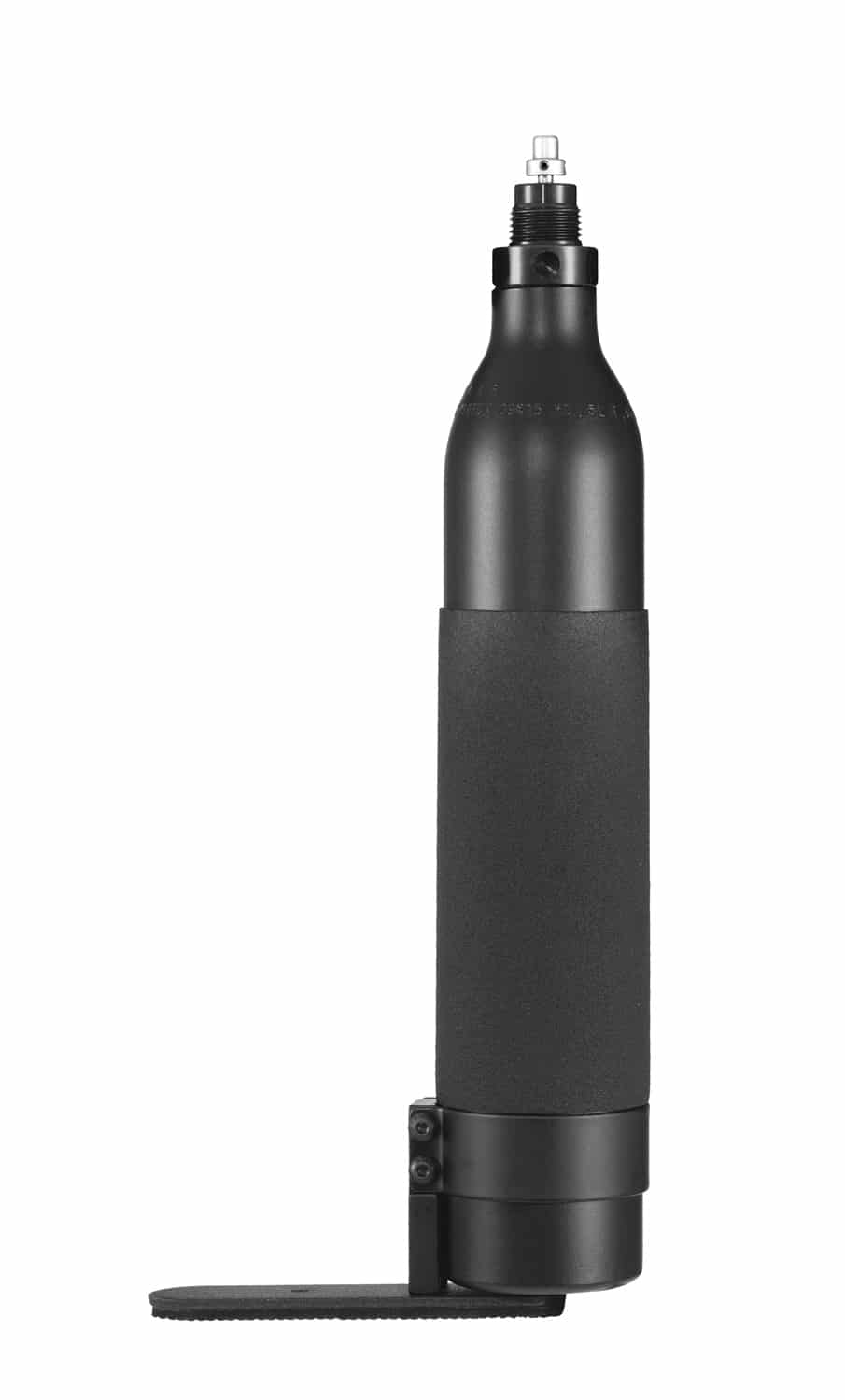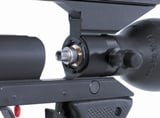 |
Micro-Meter Tank (U1047) allows rifles to shoot at moderate velocities with very low air usage. |
The Micro-Meter valve installed in a standard AirForce tank completely changes the performance of all three AirForce rifles. By restricting the volume of air that’s available for each shot, you get lower velocities that are extremely consistent. To find out how consistent, we tested each gun with the new valve/tank.
Fill pressure 3,000 psi· .22 caliber Crosman Premier pellet
| High power | Power setting 7 (medium ) |
Low power |
| High 564 | High 553 | High 547 |
| Low 561 | Low 546 | Low 403 |
| Avg. 563 | Avg. 549 | Avg. 506 |
Fill pressure 3,000 psi· .22 caliber Crosman Premier pellet
| High power | Power setting 7 (medium ) |
Low power |
| High 663 | High 659 | High 439 |
| Low 654 | Low 654 | Low 477 |
| Avg. 659 | Avg. 656 | Avg. 458 |
Fill pressure 3,000 psi· .22 caliber Crosman Premier pellet
| High power | Power setting 7 (medium ) |
Low power |
| High 693 | High 685 | High 674 |
| Low 684 | Low 679 | Low 655 |
| Avg. 689 | Avg. 682 | Avg. 665 |
What do the tank numbers mean?
The Micro-Meter tank/valve was designed to give the owners of AirForce rifles a lower-powered option with great consistency for the rifle they already own. After testing, it looks like that has been accomplished in all three rifles. There is a performance difference between the rifles that can be chiefly attributed to the different barrel lengths.
Talon SS
The SS, with its short barrel, gets the lowest velocity of all. The power adjustment wheel has very little effect until it is almost at the lowest setting, and then the consistency opens up. The average velocity of about 560 f.p.s. produces right around 10 foot-pounds in .22 caliber. Expect about 20 percent less energy in .177, which would mean that an 8-grain pellet might travel an average of around 670 f.p.s. Velocity is very consistent and should remain so for a large number of shots. If you shoot at distances of 25 yards or less, there are well over 100 accurate shots available in the new tank.
The Talon, with its 18-inch barrel, gets good consistent velocity, plus some low-end adjustability. The test results suggest that the Talon SS, with the optional 24-inch barrel installed, might be the best combination of all for the Micr-oMeter valve and tank. The average velocity of about 680 f.p.s. produces right around 14.7 foot-pounds in .22 caliber. Expect about 20 percent less energy in .177, which would be about 11.8 foot-pounds. That’s an 8-grain pellet traveling at about 815 f.p.s. Velocity is also very consistent for the Talon and should remain so for a large number of shots. If you shoot at distances of 25 yards or less, there are well over 100 accurate shots available in the new tank.
The Condor gets the most velocity from the Micro-Meter tank, but it isn’t coming from the special powerplant. It’s coming from the 24-inch barrel. The average velocity of about 689 f.p.s. produces just over 15 foot-pounds in .22 caliber. That’s very close to the Talon. Expect about 20 percent less energy in .177, which would be about 12 foot-pounds on the nose. That’s an 8-grain pellet traveling at about 822 f.p.s. The Condor has very little adjustability because of its extra-powerful power plant. But the consistency is fine. If you shoot your Condor at distances of 25 yards or less, there are well over 100 accurate shots available in the new valve/tank. Summary The Micro-Meter valve and tank is perfect for indoor target practice and pest elimination in places where over-penetration is a concern. Yes, both the Talon and Condor can be adjusted to these same low velocities, but the new Micro-Meter valve/tank gives superior consistency. This is the way to tame the powerful Condor for urban backyard shooting, and the Talon SS is virtually silent with the new valve/tank







